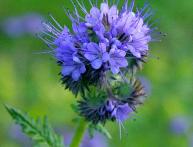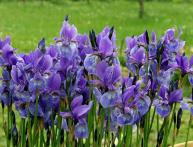How to grow tulips from seeds with your own hands from seed to flower

What else can you say about tulips? It seems that these flowers are so well known and loved that not only professionals, but also amateurs take up their cultivation. In amateur gardens, this flower can be found in any quality. Tulips are used both for decorating areas, flower beds, paths, rock gardens, and for cutting into bouquets. There are known methods for forcing these flowers to certain dates. It is commonly believed that multiply these flowers are bulbs. However, tulips are also propagated by seeds. We will try to figure out how a tulip bulb is formed, why you have to resort to seed propagation and how to grow a tulip from seeds and wait for them to bloom.
Content:
- Tulips, some botanical characteristics
- Seed propagation of tulips in nature
- Propagation of tulips by seeds in the garden
Tulips, some botanical characteristics
Tulips are flowering herbaceous bulbous plants from the genus Tulip, Liliaceae family. Over many millions of years, tulips have perfectly adapted to life in almost any conditions. They are not afraid of dry climates, cold winters, mountain or desert air. With the help of man, they advanced to Holland, where at one time they became popular and were valued as dearly as gold.Over many years of evolution, the tulip has adapted, in a very short period of favorable spring weather, not only to germinate, produce leaves and flowers, but also to form young bulbs. The old bulb dies after flowering. During the summer underground in the young bulbs Next year's shoots and flowers are forming. By the end of autumn, young bulbs form a root system. In some varieties this process continues in winter.
The tulip bulb consists of:
- from the bottom, which is a modification of the stem in the form of a disk
- one to six storage scales, specialized leaves
- protective integumentary scales
- dead remains of the mother bulb, stems, they play a protective function

Bulbs of wild tulip species live for almost two years, and cultivated ones - exactly two years. The first year is only a bud inside the mother's bulb. Next year it is a full-fledged bulb. If it is located in the center and is larger in size than the others, it is a replacement bulb. In the axils of the scales there are daughter bulbs, sometimes they are comparable in size to the central one; among the protective scales there may be small bulbs - children.
Sometimes in varietal tulips, to replace the mother bulb, only one central and one or two daughter bulbs are formed. Therefore, reproduction is quite slow. Thus, although the main type of amateur propagation of tulips is bulbs, lovers of these beautiful flowering bulbous plants can try propagating them by seed. After all, almost all tulips form after flowering. seeds.
Seed propagation of tulips in nature
The variety of commercial tulip varieties in Holland alone reaches almost two thousand.From white to almost black, from simple to double, from single-colored to striped, on low and high stems - all this diversity is difficult to even imagine. However, almost all varieties form a fruit - a capsule. Depending on the type and variety, it can be either elongated or more rounded. In some varieties, the size of the fruit - capsule can exceed 10 cm.
Inside, the box is divided into three separate compartments, and seed plates are stacked in them. They are usually triangular or ovoid in shape and quite large. In nature, the seeds fall out of a dry capsule when they crack, are carried by the wind and lie until next spring. Sometimes they don't sprout in the first year, but sprout only in the second year.
Propagation of tulips by seeds in the garden

To sow seeds on the site, the boxes with them are cut off in the first ten days of August and allowed to ripen in a warm and dry room. By the beginning of October, in the area chosen for sowing tulip seeds, you need to dig up the soil. It is better if it is light loam and add humus when digging. It is advisable to cover the sides of the bed with boards to create a kind of box. Pour sand on top, leveling it in a layer of 2 - 3 cm. A week later, around mid-October, the seeds are sown quite densely in the garden bed. They are covered with a layer of soil and sand on top. They are left in this form until spring.
In early spring, after the snow melts, a loop of green seedling appears above the surface along with the remains of the seed. In the first summer, a tulip grown from a seed looks like a single, narrow leaf, curled into a thin tube with one root. By mid-June, the leaf dries up, giving life to a small onion-scale, no more than two to three mm in size.
The following spring, the seedling sprouts with flat leaves and two roots; the small onion, dying, produces a replacement onion with a diameter equal to one cm.
Until this moment, the bulbs are not dug up, but in the winter the bed is covered with a layer of humus of 5-6 cm. In the third year, the seedling looks like a larger flat leaf, and the bulb will produce not only a fairly large, up to 2 - 2.5 cm, replacement bulb, but and a couple of baby bulbs. As a rule, they are dug up in mid-summer and stored until autumn. Room for storage must be dry. In October, both the replacement bulb and the children are embedded in the soil at a depth of 12 - 15 cm. Before planting, the grooves are filled with sand, watered with salted water and the bulbs are laid out at a distance of 3-4 cm. The bed is mulched with humus or rotted manure.
The next year everything repeats itself. The first flowering of replacement bulbs and daughter bulbs obtained from seeds can be seen only in the fifth or sixth year, and small bulbs - children must grow stronger during another season. The process of obtaining flowering tulip bulbs from seeds takes at least five years. However, the bulbs of many varietal tulips are quite difficult to find and they cost a lot. Therefore, lovers of these beautiful flowering bulbous plants can try propagating tulips by seed.
Video about quickly growing tulips:
Interesting information about the vegetable garden










